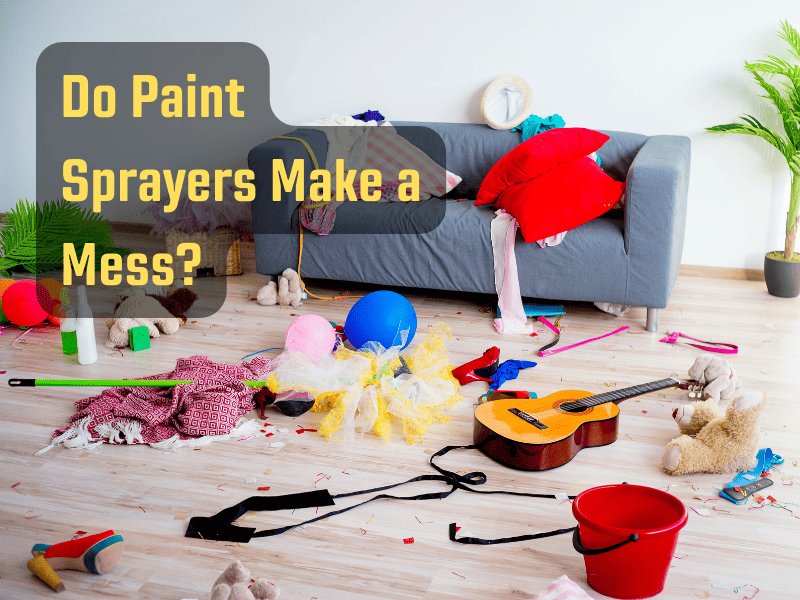Paint sprayers have revolutionized how we approach painting projects, providing faster and more efficient results than traditional brush and roller methods. However, one common concern among many people considering the use of paint sprayers is whether they make a mess. In this article, we will delve into the topic to provide you with a comprehensive understanding of the potential messiness associated with paint sprayers. By the end, you will have a clearer picture of what to expect and how to minimize any mess during your painting endeavors.
Table of Contents
Understanding Paint Sprayers
Before we dive into the messiness aspect, let’s briefly recap what paint sprayers are and how they work. Paint sprayers are devices that use compressed air or high-pressure systems to spray paint onto surfaces. They consist of a nozzle, a container for holding the paint, and a mechanism to propel the paint forward.
Paint sprayers are available in different types, including airless sprayers, HVLP (High Volume, Low Pressure) sprayers, and compressed air sprayers. Each type has its own advantages and is suitable for specific applications. Regardless of the type, paint sprayers are known for their ability to cover large areas quickly and evenly, making them highly popular among professional painters and DIY enthusiasts.
Addressing the Myth of Messiness
The common misconception is that paint sprayer inevitably lead to a messy painting experience. While it’s true that using a paint sprayer requires proper technique and preparation, the messiness factor largely depends on the user’s skill, the type of sprayer used, and the precautions taken. Let’s explore the factors that can contribute to messiness and how to mitigate them effectively.
Overspray: Managing the Fine Mist
One of the primary concerns when it comes to painting sprayers is overspray—the fine mist of paint particles that can travel beyond the intended target area. Overspray can potentially create a messy environment if not controlled properly.
Choosing the Right Sprayer
The type of sprayer you choose can significantly impact the amount of overspray produced. Airless sprayers, for instance, tend to generate more overspray than HVLP sprayers, designed to deliver a higher percentage of paint onto the surface. If minimizing mess is a priority for your project, opting for an HVLP sprayer might be wise.
Preparation and Masking
Proper preparation and masking play a vital role in containing overspray and reducing mess. Before spraying, ensure you cover and protect any surfaces, furniture, or objects you don’t want to be painted. Plastic drop cloths, masking tape, and painter’s paper are essential tools in this regard. Take the time to properly mask off areas to minimize the chances of overspray spreading beyond the intended target.
Technique and Control
Skill and technique are crucial when using a paint sprayer. Holding the sprayer at the correct distance from the surface and maintaining a steady and consistent motion can help you control the spray pattern and reduce overspray. Practicing your technique beforehand on a scrap surface or in a controlled environment can significantly improve your ability to achieve clean and precise results with minimal mess.
Drips and Run-offs: Ensuring Proper Application
Another aspect that can contribute to messiness is the potential for drips and run-offs when using a paint sprayer. However, it’s important to note that drips and run-offs can occur with any painting method if not applied correctly. Here are some tips to help you minimize the chances of drips and run-offs:
Consistency of Paint
The consistency of the paint you use can greatly affect the likelihood of drips and run-offs. Follow the manufacturer’s recommendations for thinning the paint if necessary. Properly thinned paint will adhere better to surfaces
and flow more evenly, reducing the chances of drips and run-offs.
Sprayer Settings and Technique
Adjusting the sprayer settings to achieve the desired flow rate and spray pattern is essential for avoiding excess paint accumulation that can lead to drips. Additionally, using the correct technique, such as maintaining a consistent distance from the surface and using smooth and even strokes, can help prevent uneven application and minimize the potential for drips and run-offs.
Patience and Multiple Coats
Applying multiple thin coats of paint instead of one thick coat can help prevent drips and run-offs. Allowing each coat to dry before applying the next gives the paint ample time to adhere and set properly, reducing the chances of messy outcomes.
Cleanup and Maintenance
Even with the best precautions in place, some cleanup may still be involved when using a paint sprayer. However, following a few simple steps can streamline the cleanup process and minimize any mess left behind.
Protecting the Surrounding Area
Similar to the masking and preparation process, protecting the surrounding area before you start painting can help contain any potential mess. Use drop cloths, plastic sheets, or newspapers to cover floors, furniture, and other items. This will make cleanup easier and prevent any accidental spills or drips from damaging your belongings.
Cleaning the Sprayer
Properly cleaning your paint sprayer after each use is crucial for maintaining its performance and preventing clogs. Refer to the manufacturer’s instructions for specific cleaning guidelines. Typically, the process involves flushing out the sprayer with an appropriate cleaning solution and thoroughly disassembling and cleaning the components. By investing time in cleaning your sprayer, you ensure its longevity and minimize the chances of residual paint causing future messes.
Conclusion
In conclusion, paint sprayers can indeed make a mess if not used properly or if the necessary precautions are not taken. However, you can significantly minimize messiness by choosing the right type of sprayer, practicing proper technique, preparing the area, and maintaining cleanliness throughout the process. Remember to be patient, take your time, and practice your spraying technique before tackling larger projects. Doing so can harness the efficiency and effectiveness of paint sprayers while keeping messes at bay. Happy painting!
